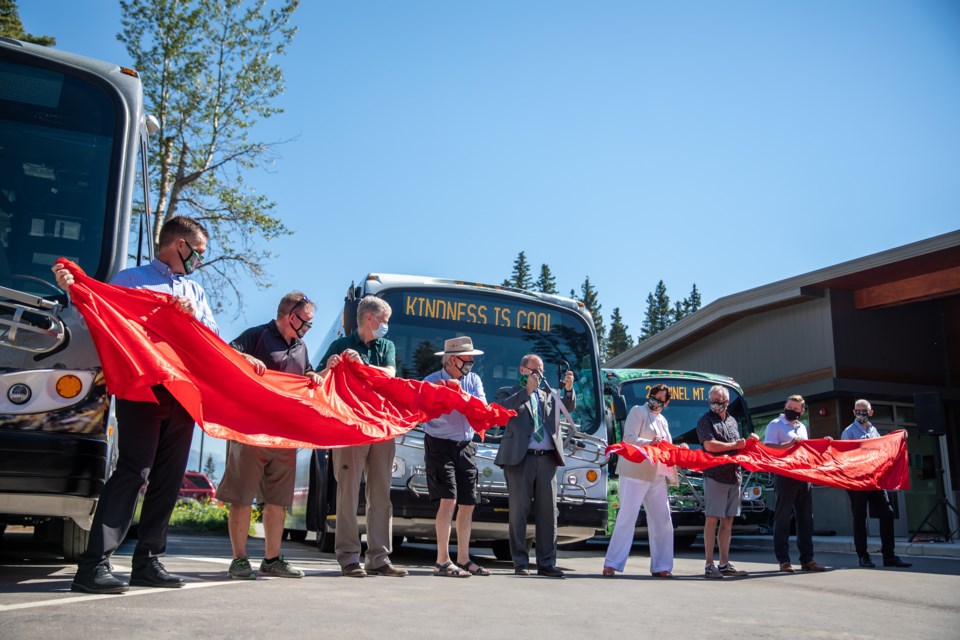BANFF – The Bow Valley officially launched its latest commitment to transit and reducing greenhouse gas emissions.
The new Roam transit operations and training centre facility was unveiled Tuesday (June 29), as the local transit system welcomed new electric buses to its fleet and a central building for its services.
“I am very proud of the creation of a robust transit system that started in Banff and is now serving the Bow Valley, and is very much the envy of many much larger communities,” said Banff Mayor Karen Sorensen in a release. “This is the Town of Banff’s most advanced green building project to date, demonstrating our commitment to being a model environmental community that can inspire the world, while providing the most convenient and cost-effective way for residents and visitors to get around Banff and Banff National Park.”
The 2,500-square-metre (27,000-square-feet) offers a state-of-the-art driver training simulator, will house the administrative offices and offers indoor and covered storage for 32 buses – 12 inside and 20 outside. The building also has a wash area and charging stations for the electric buses.
“It takes a toll on the buses being outside all the time,” said Martin Bean, the CAO of the Bow Valley Regional Transit Services Commission (BVRTSC). “This building allows us to park our primary winter fleet fully inside and the remainder outside with covered canopies, protected from the elements, which will increase the life expectancy of the buses.”
The $8.5 million facility was largely funded through the province’s GreenTRIP program. The building is powered through the largest solar array in either of Banff of Jasper national parks and is a net zero carbon design. The array was funded by the Alberta Municipal Solar Program.
The heating is entirely through biomass energy district heating that turns wood waste into heat energy and doesn’t rely on a natural gas connection.
“Today is a major milestone for Roam public transit and for the Bow Valley,” said Brian Standish, the chair of the Bow Valley Regional Transit Services Commission. “We are making public transit better, our air cleaner, and our communities healthier. We are moving forward on our goals to preserve our world-class national park and mountain towns for years to come.”
The training simulator is also expected to reduce costs associated with training, improve safety and see a cutting of greenhouse gas emissions with up to 40 per cent of training expected to be done through the simulator.
Bean said an added bonus is being able to simulate situations such as a pedestrian stepping into the road, a cyclist or skateboarder cutting in front of the bus or a vehicle suddenly stopping ahead of the bus.
“It’s very progressive for an agency of our size. We’re the only small transit agency in the province with the simulator and the full training centre. We’re also one of the few transit agencies in the province to provide the Alberta MELT (Mandatory Entry-Level Training) training for Class 2 drivers.”
Public transit in the valley has grown as more people turn to Roam to get from one destination to the next. Bean said they had seven buses in 2015 and have now grown to 27. Of those, three are hybrid and three are fully electric.
The three electric buses are adorned with a wolf pack, the snowshoe hare and the pine marten, maintaining the theme of buses having wildlife imagery.
They also have another electric bus on order - funded by Parks Canada and GreenTRIP – mainly for the Lake Minnewanka route and another electric bus paid for by the Town of Canmore and GreenTRIP for a seasonal route in the Grassi Lakes region.
The two buses are expected to be delivered before the end of the year, Bean said.
Bean noted one of the strongest aspects of the transit system is the coming together of multiple regional municipalities in providing the service.
“The big advantage we have is the municipalities collaborate very well. Banff, Canmore and Improvement District No. 9 all want to make transit better, so people can move around the valley without having to either own a vehicle or use their vehicle. You don’t typically see this kind of collaboration.”




